Integrated Marketing Communication for Priya Restaurant in Sydney
VerifiedAdded on 2022/09/14
|13
|2913
|13
Report
AI Summary
This report details the integrated marketing communications (IMC) campaign for the launch of Priya Restaurant in Sydney. The report begins by outlining key strategic decisions, including the campaign's objective to generate brand awareness during the pre-launch, launch, and initial two months of operation. It then analyzes the communication model, emphasizing goal setting through digital marketing, particularly promoting products and cuisine preferences via direct email, mobile app pop-ups, and other channels. The report further examines the target market, employing demographic and psychographic segmentation, and explores brand positioning through defining the target customers, brand essence, brand promise, and brand personality. The marketing mix is discussed, including advertising, personal selling, discounts, and promotions. The report also covers platforms, objectives, synergy, message strategy, and key consumer and brand relationship insights, including message direction and strategic consistency. The campaign's focus is on establishing a strong brand presence and attracting a diverse customer base in the new Sydney location.
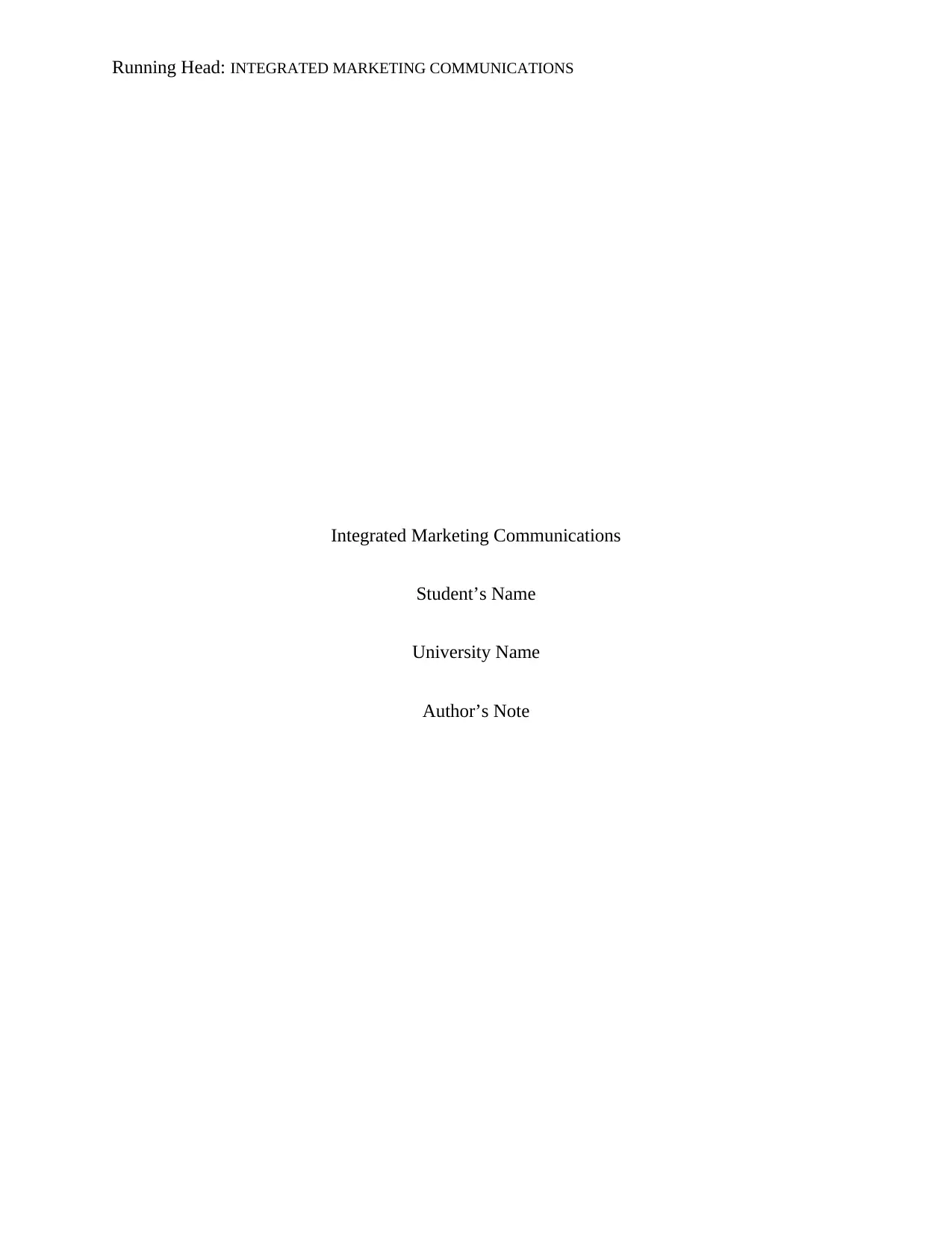
Running Head: INTEGRATED MARKETING COMMUNICATIONS
Integrated Marketing Communications
Student’s Name
University Name
Author’s Note
Integrated Marketing Communications
Student’s Name
University Name
Author’s Note
Paraphrase This Document
Need a fresh take? Get an instant paraphrase of this document with our AI Paraphraser
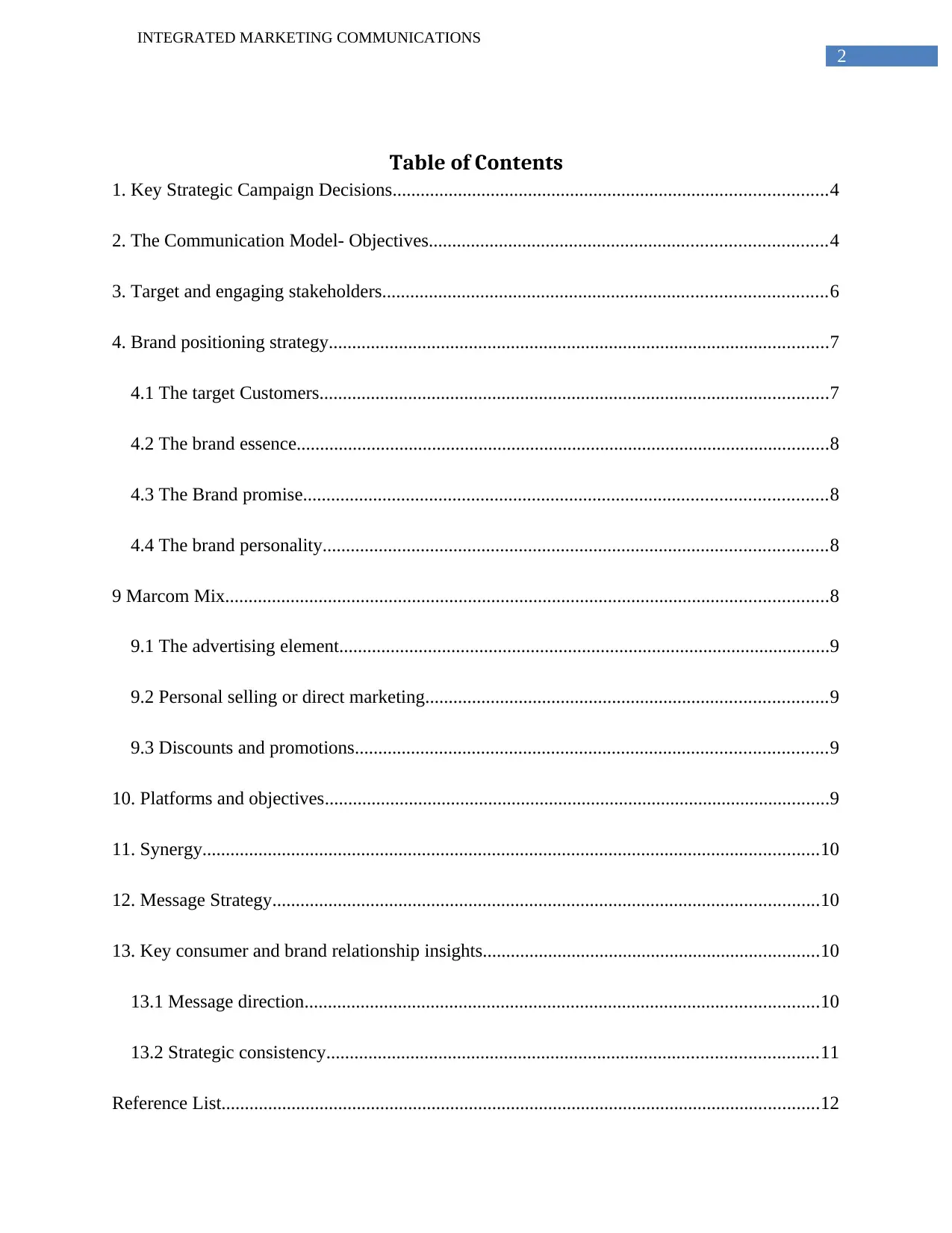
2
INTEGRATED MARKETING COMMUNICATIONS
Table of Contents
1. Key Strategic Campaign Decisions.............................................................................................4
2. The Communication Model- Objectives.....................................................................................4
3. Target and engaging stakeholders...............................................................................................6
4. Brand positioning strategy...........................................................................................................7
4.1 The target Customers.............................................................................................................7
4.2 The brand essence..................................................................................................................8
4.3 The Brand promise................................................................................................................8
4.4 The brand personality............................................................................................................8
9 Marcom Mix.................................................................................................................................8
9.1 The advertising element.........................................................................................................9
9.2 Personal selling or direct marketing......................................................................................9
9.3 Discounts and promotions.....................................................................................................9
10. Platforms and objectives............................................................................................................9
11. Synergy....................................................................................................................................10
12. Message Strategy.....................................................................................................................10
13. Key consumer and brand relationship insights........................................................................10
13.1 Message direction..............................................................................................................10
13.2 Strategic consistency.........................................................................................................11
Reference List................................................................................................................................12
INTEGRATED MARKETING COMMUNICATIONS
Table of Contents
1. Key Strategic Campaign Decisions.............................................................................................4
2. The Communication Model- Objectives.....................................................................................4
3. Target and engaging stakeholders...............................................................................................6
4. Brand positioning strategy...........................................................................................................7
4.1 The target Customers.............................................................................................................7
4.2 The brand essence..................................................................................................................8
4.3 The Brand promise................................................................................................................8
4.4 The brand personality............................................................................................................8
9 Marcom Mix.................................................................................................................................8
9.1 The advertising element.........................................................................................................9
9.2 Personal selling or direct marketing......................................................................................9
9.3 Discounts and promotions.....................................................................................................9
10. Platforms and objectives............................................................................................................9
11. Synergy....................................................................................................................................10
12. Message Strategy.....................................................................................................................10
13. Key consumer and brand relationship insights........................................................................10
13.1 Message direction..............................................................................................................10
13.2 Strategic consistency.........................................................................................................11
Reference List................................................................................................................................12

3
INTEGRATED MARKETING COMMUNICATIONS
INTEGRATED MARKETING COMMUNICATIONS
⊘ This is a preview!⊘
Do you want full access?
Subscribe today to unlock all pages.

Trusted by 1+ million students worldwide
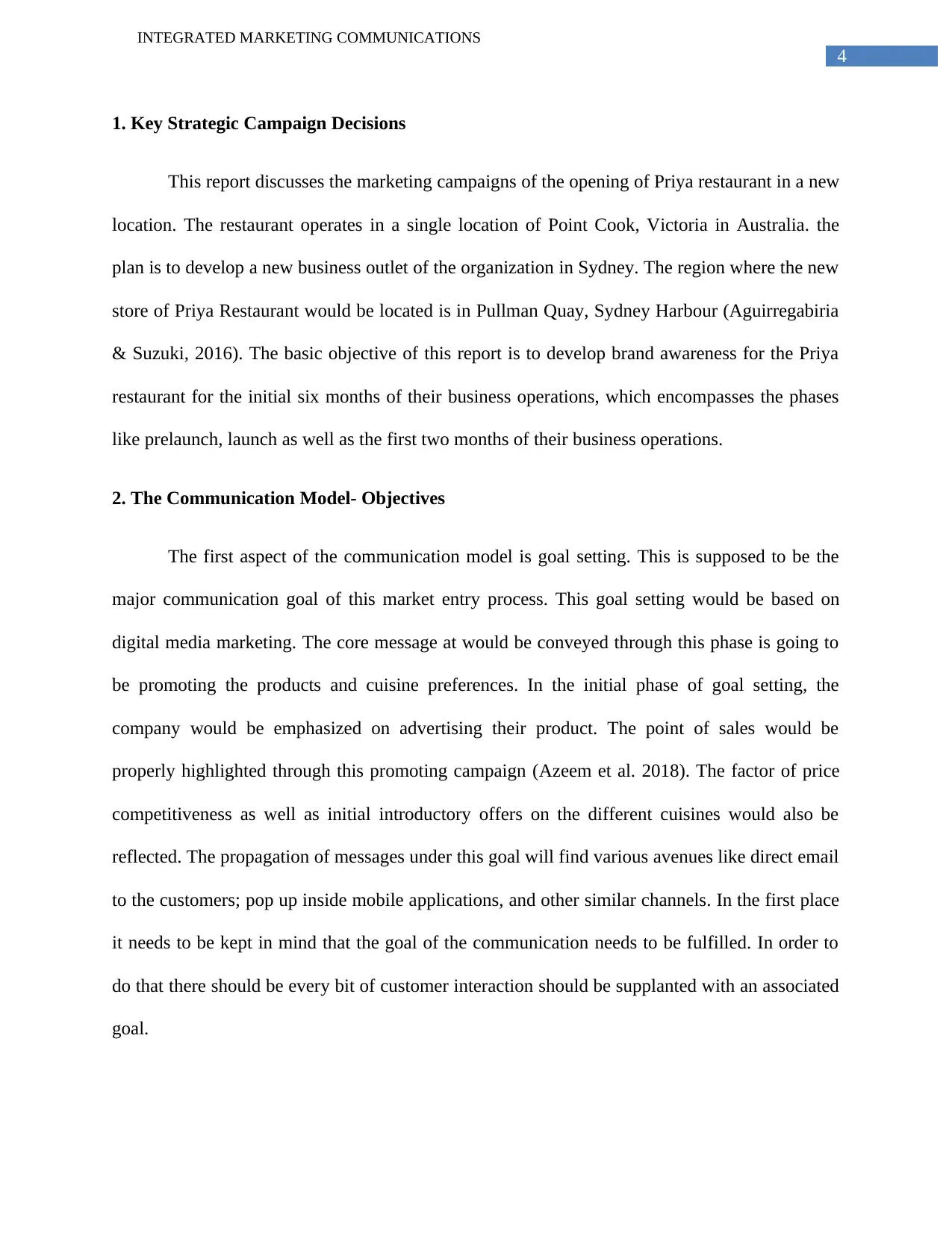
4
INTEGRATED MARKETING COMMUNICATIONS
1. Key Strategic Campaign Decisions
This report discusses the marketing campaigns of the opening of Priya restaurant in a new
location. The restaurant operates in a single location of Point Cook, Victoria in Australia. the
plan is to develop a new business outlet of the organization in Sydney. The region where the new
store of Priya Restaurant would be located is in Pullman Quay, Sydney Harbour (Aguirregabiria
& Suzuki, 2016). The basic objective of this report is to develop brand awareness for the Priya
restaurant for the initial six months of their business operations, which encompasses the phases
like prelaunch, launch as well as the first two months of their business operations.
2. The Communication Model- Objectives
The first aspect of the communication model is goal setting. This is supposed to be the
major communication goal of this market entry process. This goal setting would be based on
digital media marketing. The core message at would be conveyed through this phase is going to
be promoting the products and cuisine preferences. In the initial phase of goal setting, the
company would be emphasized on advertising their product. The point of sales would be
properly highlighted through this promoting campaign (Azeem et al. 2018). The factor of price
competitiveness as well as initial introductory offers on the different cuisines would also be
reflected. The propagation of messages under this goal will find various avenues like direct email
to the customers; pop up inside mobile applications, and other similar channels. In the first place
it needs to be kept in mind that the goal of the communication needs to be fulfilled. In order to
do that there should be every bit of customer interaction should be supplanted with an associated
goal.
INTEGRATED MARKETING COMMUNICATIONS
1. Key Strategic Campaign Decisions
This report discusses the marketing campaigns of the opening of Priya restaurant in a new
location. The restaurant operates in a single location of Point Cook, Victoria in Australia. the
plan is to develop a new business outlet of the organization in Sydney. The region where the new
store of Priya Restaurant would be located is in Pullman Quay, Sydney Harbour (Aguirregabiria
& Suzuki, 2016). The basic objective of this report is to develop brand awareness for the Priya
restaurant for the initial six months of their business operations, which encompasses the phases
like prelaunch, launch as well as the first two months of their business operations.
2. The Communication Model- Objectives
The first aspect of the communication model is goal setting. This is supposed to be the
major communication goal of this market entry process. This goal setting would be based on
digital media marketing. The core message at would be conveyed through this phase is going to
be promoting the products and cuisine preferences. In the initial phase of goal setting, the
company would be emphasized on advertising their product. The point of sales would be
properly highlighted through this promoting campaign (Azeem et al. 2018). The factor of price
competitiveness as well as initial introductory offers on the different cuisines would also be
reflected. The propagation of messages under this goal will find various avenues like direct email
to the customers; pop up inside mobile applications, and other similar channels. In the first place
it needs to be kept in mind that the goal of the communication needs to be fulfilled. In order to
do that there should be every bit of customer interaction should be supplanted with an associated
goal.
Paraphrase This Document
Need a fresh take? Get an instant paraphrase of this document with our AI Paraphraser
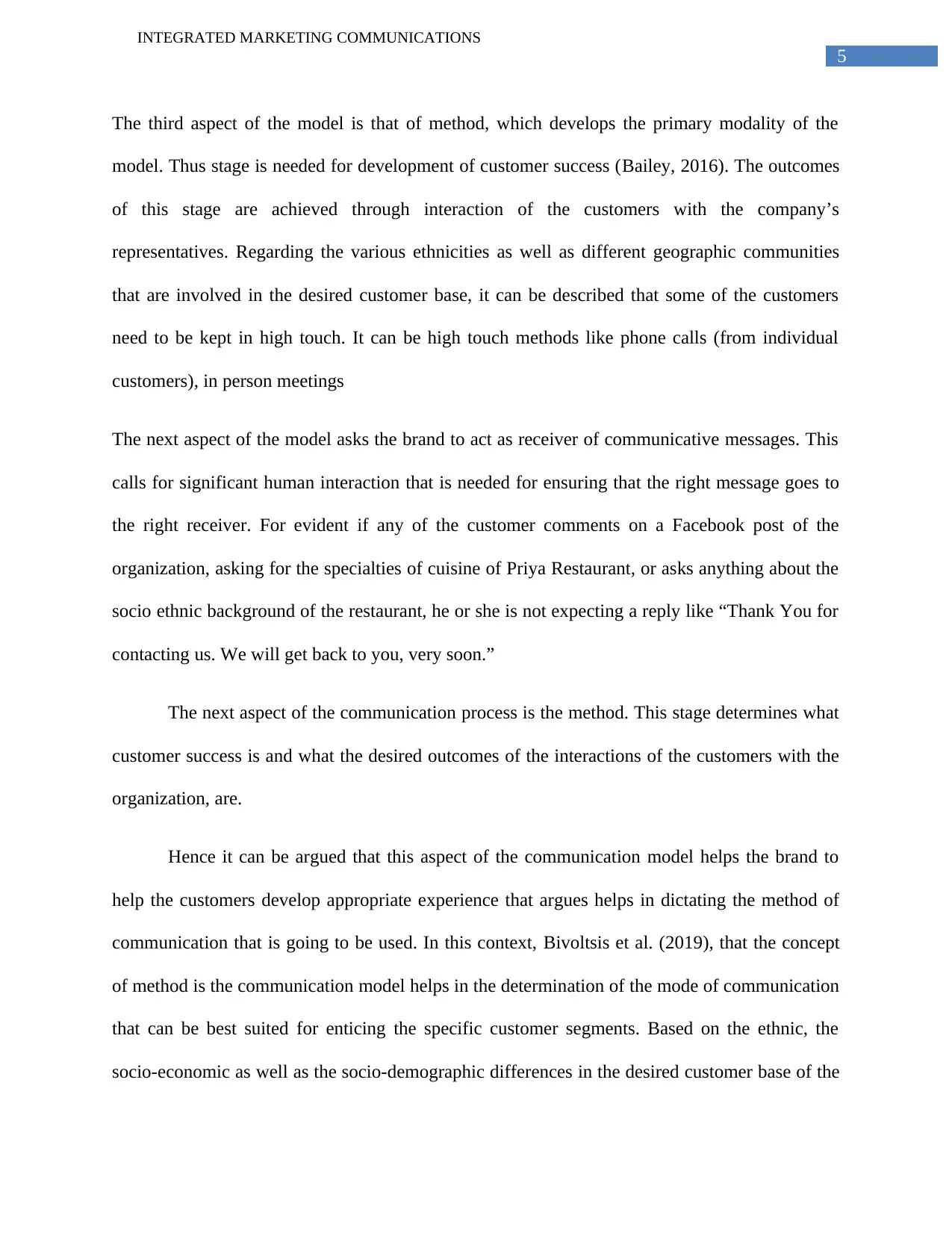
5
INTEGRATED MARKETING COMMUNICATIONS
The third aspect of the model is that of method, which develops the primary modality of the
model. Thus stage is needed for development of customer success (Bailey, 2016). The outcomes
of this stage are achieved through interaction of the customers with the company’s
representatives. Regarding the various ethnicities as well as different geographic communities
that are involved in the desired customer base, it can be described that some of the customers
need to be kept in high touch. It can be high touch methods like phone calls (from individual
customers), in person meetings
The next aspect of the model asks the brand to act as receiver of communicative messages. This
calls for significant human interaction that is needed for ensuring that the right message goes to
the right receiver. For evident if any of the customer comments on a Facebook post of the
organization, asking for the specialties of cuisine of Priya Restaurant, or asks anything about the
socio ethnic background of the restaurant, he or she is not expecting a reply like “Thank You for
contacting us. We will get back to you, very soon.”
The next aspect of the communication process is the method. This stage determines what
customer success is and what the desired outcomes of the interactions of the customers with the
organization, are.
Hence it can be argued that this aspect of the communication model helps the brand to
help the customers develop appropriate experience that argues helps in dictating the method of
communication that is going to be used. In this context, Bivoltsis et al. (2019), that the concept
of method is the communication model helps in the determination of the mode of communication
that can be best suited for enticing the specific customer segments. Based on the ethnic, the
socio-economic as well as the socio-demographic differences in the desired customer base of the
INTEGRATED MARKETING COMMUNICATIONS
The third aspect of the model is that of method, which develops the primary modality of the
model. Thus stage is needed for development of customer success (Bailey, 2016). The outcomes
of this stage are achieved through interaction of the customers with the company’s
representatives. Regarding the various ethnicities as well as different geographic communities
that are involved in the desired customer base, it can be described that some of the customers
need to be kept in high touch. It can be high touch methods like phone calls (from individual
customers), in person meetings
The next aspect of the model asks the brand to act as receiver of communicative messages. This
calls for significant human interaction that is needed for ensuring that the right message goes to
the right receiver. For evident if any of the customer comments on a Facebook post of the
organization, asking for the specialties of cuisine of Priya Restaurant, or asks anything about the
socio ethnic background of the restaurant, he or she is not expecting a reply like “Thank You for
contacting us. We will get back to you, very soon.”
The next aspect of the communication process is the method. This stage determines what
customer success is and what the desired outcomes of the interactions of the customers with the
organization, are.
Hence it can be argued that this aspect of the communication model helps the brand to
help the customers develop appropriate experience that argues helps in dictating the method of
communication that is going to be used. In this context, Bivoltsis et al. (2019), that the concept
of method is the communication model helps in the determination of the mode of communication
that can be best suited for enticing the specific customer segments. Based on the ethnic, the
socio-economic as well as the socio-demographic differences in the desired customer base of the
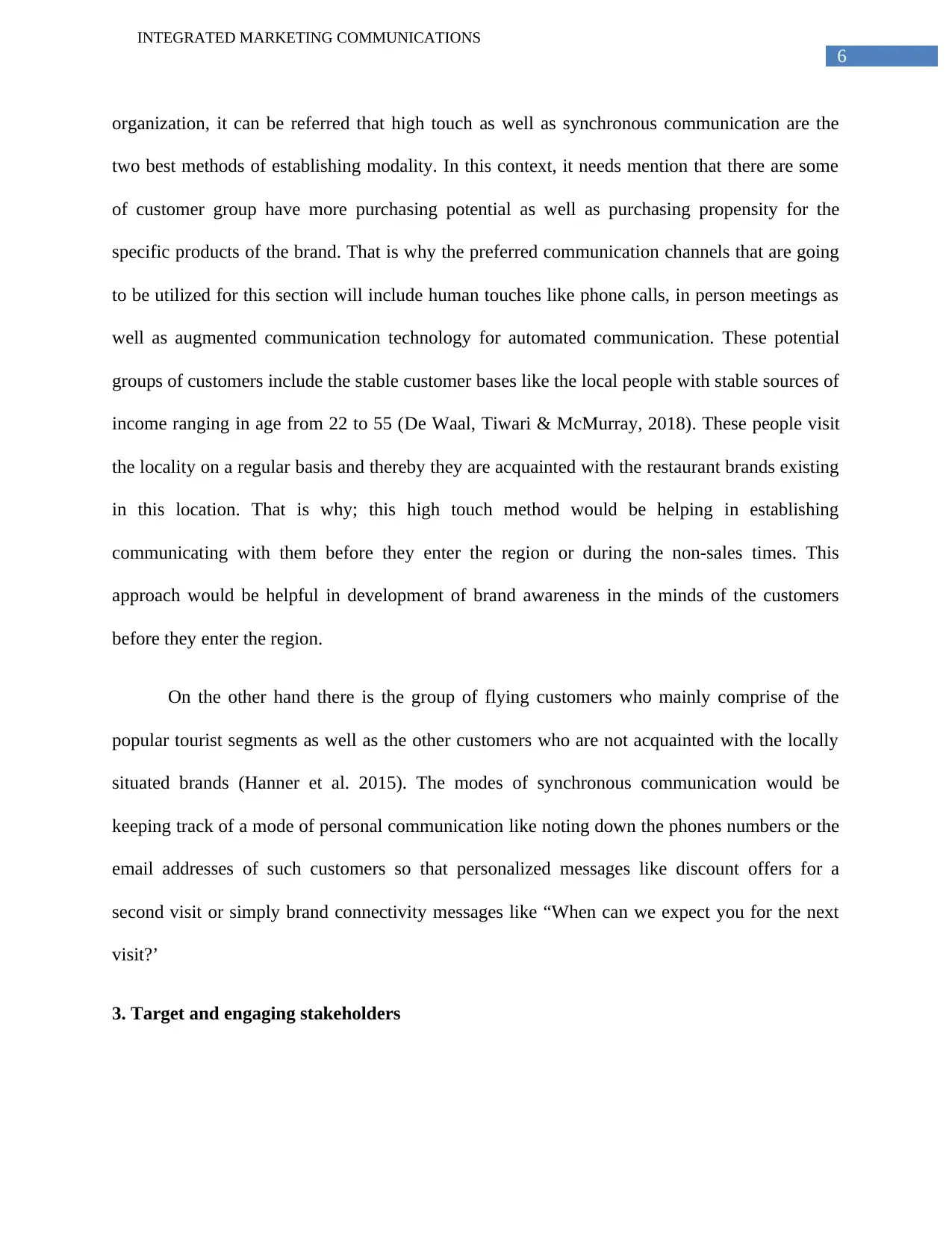
6
INTEGRATED MARKETING COMMUNICATIONS
organization, it can be referred that high touch as well as synchronous communication are the
two best methods of establishing modality. In this context, it needs mention that there are some
of customer group have more purchasing potential as well as purchasing propensity for the
specific products of the brand. That is why the preferred communication channels that are going
to be utilized for this section will include human touches like phone calls, in person meetings as
well as augmented communication technology for automated communication. These potential
groups of customers include the stable customer bases like the local people with stable sources of
income ranging in age from 22 to 55 (De Waal, Tiwari & McMurray, 2018). These people visit
the locality on a regular basis and thereby they are acquainted with the restaurant brands existing
in this location. That is why; this high touch method would be helping in establishing
communicating with them before they enter the region or during the non-sales times. This
approach would be helpful in development of brand awareness in the minds of the customers
before they enter the region.
On the other hand there is the group of flying customers who mainly comprise of the
popular tourist segments as well as the other customers who are not acquainted with the locally
situated brands (Hanner et al. 2015). The modes of synchronous communication would be
keeping track of a mode of personal communication like noting down the phones numbers or the
email addresses of such customers so that personalized messages like discount offers for a
second visit or simply brand connectivity messages like “When can we expect you for the next
visit?’
3. Target and engaging stakeholders
INTEGRATED MARKETING COMMUNICATIONS
organization, it can be referred that high touch as well as synchronous communication are the
two best methods of establishing modality. In this context, it needs mention that there are some
of customer group have more purchasing potential as well as purchasing propensity for the
specific products of the brand. That is why the preferred communication channels that are going
to be utilized for this section will include human touches like phone calls, in person meetings as
well as augmented communication technology for automated communication. These potential
groups of customers include the stable customer bases like the local people with stable sources of
income ranging in age from 22 to 55 (De Waal, Tiwari & McMurray, 2018). These people visit
the locality on a regular basis and thereby they are acquainted with the restaurant brands existing
in this location. That is why; this high touch method would be helping in establishing
communicating with them before they enter the region or during the non-sales times. This
approach would be helpful in development of brand awareness in the minds of the customers
before they enter the region.
On the other hand there is the group of flying customers who mainly comprise of the
popular tourist segments as well as the other customers who are not acquainted with the locally
situated brands (Hanner et al. 2015). The modes of synchronous communication would be
keeping track of a mode of personal communication like noting down the phones numbers or the
email addresses of such customers so that personalized messages like discount offers for a
second visit or simply brand connectivity messages like “When can we expect you for the next
visit?’
3. Target and engaging stakeholders
⊘ This is a preview!⊘
Do you want full access?
Subscribe today to unlock all pages.

Trusted by 1+ million students worldwide
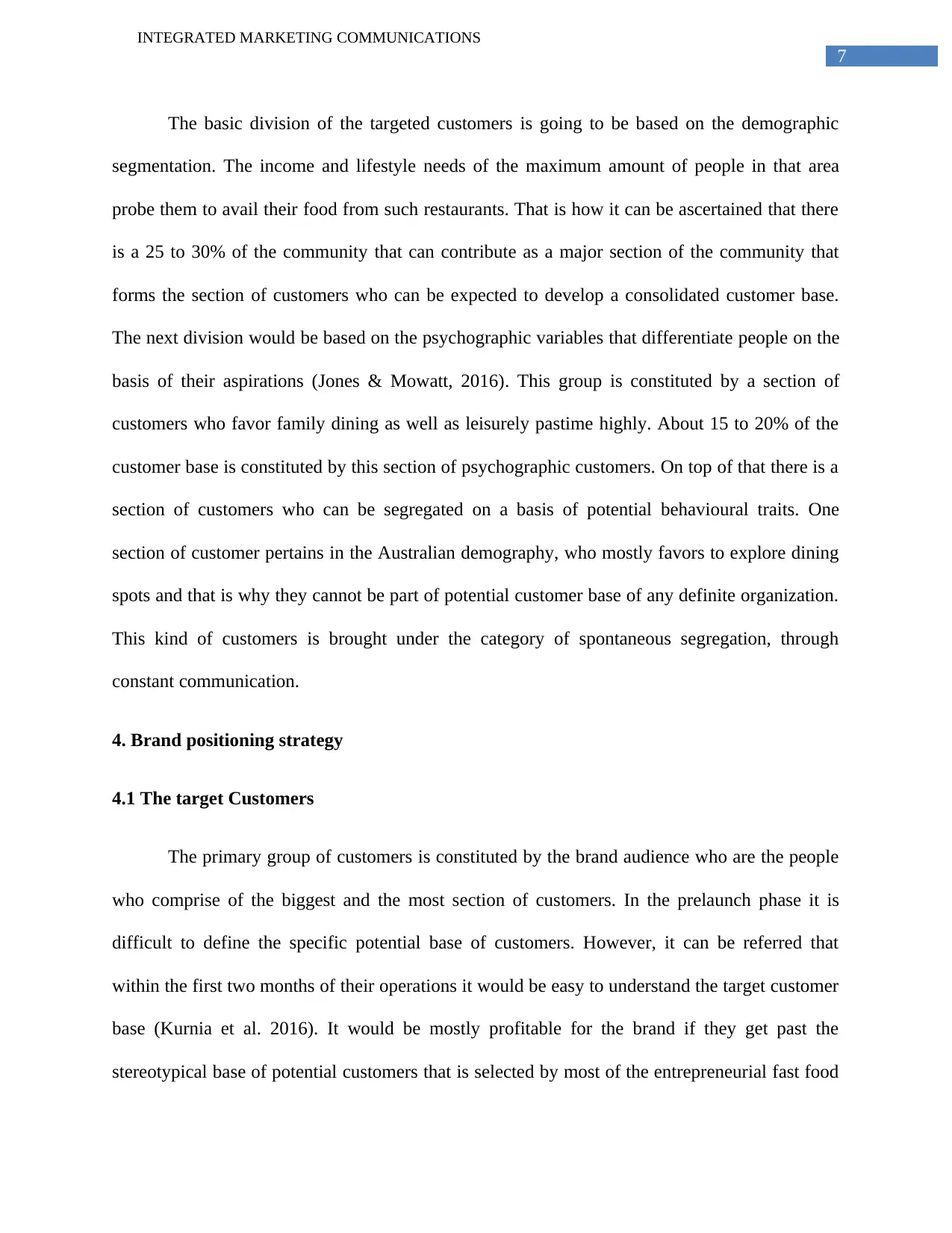
7
INTEGRATED MARKETING COMMUNICATIONS
The basic division of the targeted customers is going to be based on the demographic
segmentation. The income and lifestyle needs of the maximum amount of people in that area
probe them to avail their food from such restaurants. That is how it can be ascertained that there
is a 25 to 30% of the community that can contribute as a major section of the community that
forms the section of customers who can be expected to develop a consolidated customer base.
The next division would be based on the psychographic variables that differentiate people on the
basis of their aspirations (Jones & Mowatt, 2016). This group is constituted by a section of
customers who favor family dining as well as leisurely pastime highly. About 15 to 20% of the
customer base is constituted by this section of psychographic customers. On top of that there is a
section of customers who can be segregated on a basis of potential behavioural traits. One
section of customer pertains in the Australian demography, who mostly favors to explore dining
spots and that is why they cannot be part of potential customer base of any definite organization.
This kind of customers is brought under the category of spontaneous segregation, through
constant communication.
4. Brand positioning strategy
4.1 The target Customers
The primary group of customers is constituted by the brand audience who are the people
who comprise of the biggest and the most section of customers. In the prelaunch phase it is
difficult to define the specific potential base of customers. However, it can be referred that
within the first two months of their operations it would be easy to understand the target customer
base (Kurnia et al. 2016). It would be mostly profitable for the brand if they get past the
stereotypical base of potential customers that is selected by most of the entrepreneurial fast food
INTEGRATED MARKETING COMMUNICATIONS
The basic division of the targeted customers is going to be based on the demographic
segmentation. The income and lifestyle needs of the maximum amount of people in that area
probe them to avail their food from such restaurants. That is how it can be ascertained that there
is a 25 to 30% of the community that can contribute as a major section of the community that
forms the section of customers who can be expected to develop a consolidated customer base.
The next division would be based on the psychographic variables that differentiate people on the
basis of their aspirations (Jones & Mowatt, 2016). This group is constituted by a section of
customers who favor family dining as well as leisurely pastime highly. About 15 to 20% of the
customer base is constituted by this section of psychographic customers. On top of that there is a
section of customers who can be segregated on a basis of potential behavioural traits. One
section of customer pertains in the Australian demography, who mostly favors to explore dining
spots and that is why they cannot be part of potential customer base of any definite organization.
This kind of customers is brought under the category of spontaneous segregation, through
constant communication.
4. Brand positioning strategy
4.1 The target Customers
The primary group of customers is constituted by the brand audience who are the people
who comprise of the biggest and the most section of customers. In the prelaunch phase it is
difficult to define the specific potential base of customers. However, it can be referred that
within the first two months of their operations it would be easy to understand the target customer
base (Kurnia et al. 2016). It would be mostly profitable for the brand if they get past the
stereotypical base of potential customers that is selected by most of the entrepreneurial fast food
Paraphrase This Document
Need a fresh take? Get an instant paraphrase of this document with our AI Paraphraser
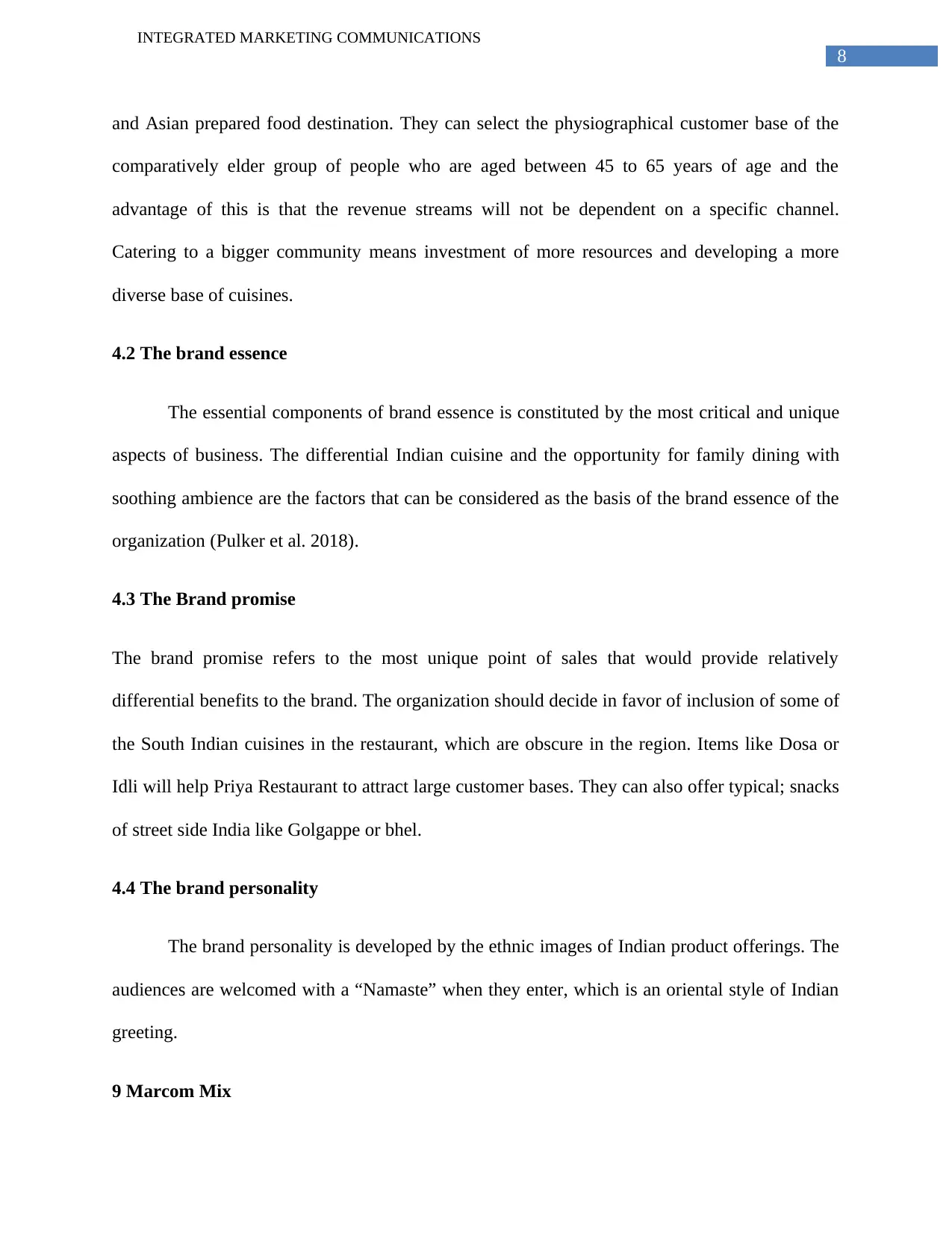
8
INTEGRATED MARKETING COMMUNICATIONS
and Asian prepared food destination. They can select the physiographical customer base of the
comparatively elder group of people who are aged between 45 to 65 years of age and the
advantage of this is that the revenue streams will not be dependent on a specific channel.
Catering to a bigger community means investment of more resources and developing a more
diverse base of cuisines.
4.2 The brand essence
The essential components of brand essence is constituted by the most critical and unique
aspects of business. The differential Indian cuisine and the opportunity for family dining with
soothing ambience are the factors that can be considered as the basis of the brand essence of the
organization (Pulker et al. 2018).
4.3 The Brand promise
The brand promise refers to the most unique point of sales that would provide relatively
differential benefits to the brand. The organization should decide in favor of inclusion of some of
the South Indian cuisines in the restaurant, which are obscure in the region. Items like Dosa or
Idli will help Priya Restaurant to attract large customer bases. They can also offer typical; snacks
of street side India like Golgappe or bhel.
4.4 The brand personality
The brand personality is developed by the ethnic images of Indian product offerings. The
audiences are welcomed with a “Namaste” when they enter, which is an oriental style of Indian
greeting.
9 Marcom Mix
INTEGRATED MARKETING COMMUNICATIONS
and Asian prepared food destination. They can select the physiographical customer base of the
comparatively elder group of people who are aged between 45 to 65 years of age and the
advantage of this is that the revenue streams will not be dependent on a specific channel.
Catering to a bigger community means investment of more resources and developing a more
diverse base of cuisines.
4.2 The brand essence
The essential components of brand essence is constituted by the most critical and unique
aspects of business. The differential Indian cuisine and the opportunity for family dining with
soothing ambience are the factors that can be considered as the basis of the brand essence of the
organization (Pulker et al. 2018).
4.3 The Brand promise
The brand promise refers to the most unique point of sales that would provide relatively
differential benefits to the brand. The organization should decide in favor of inclusion of some of
the South Indian cuisines in the restaurant, which are obscure in the region. Items like Dosa or
Idli will help Priya Restaurant to attract large customer bases. They can also offer typical; snacks
of street side India like Golgappe or bhel.
4.4 The brand personality
The brand personality is developed by the ethnic images of Indian product offerings. The
audiences are welcomed with a “Namaste” when they enter, which is an oriental style of Indian
greeting.
9 Marcom Mix
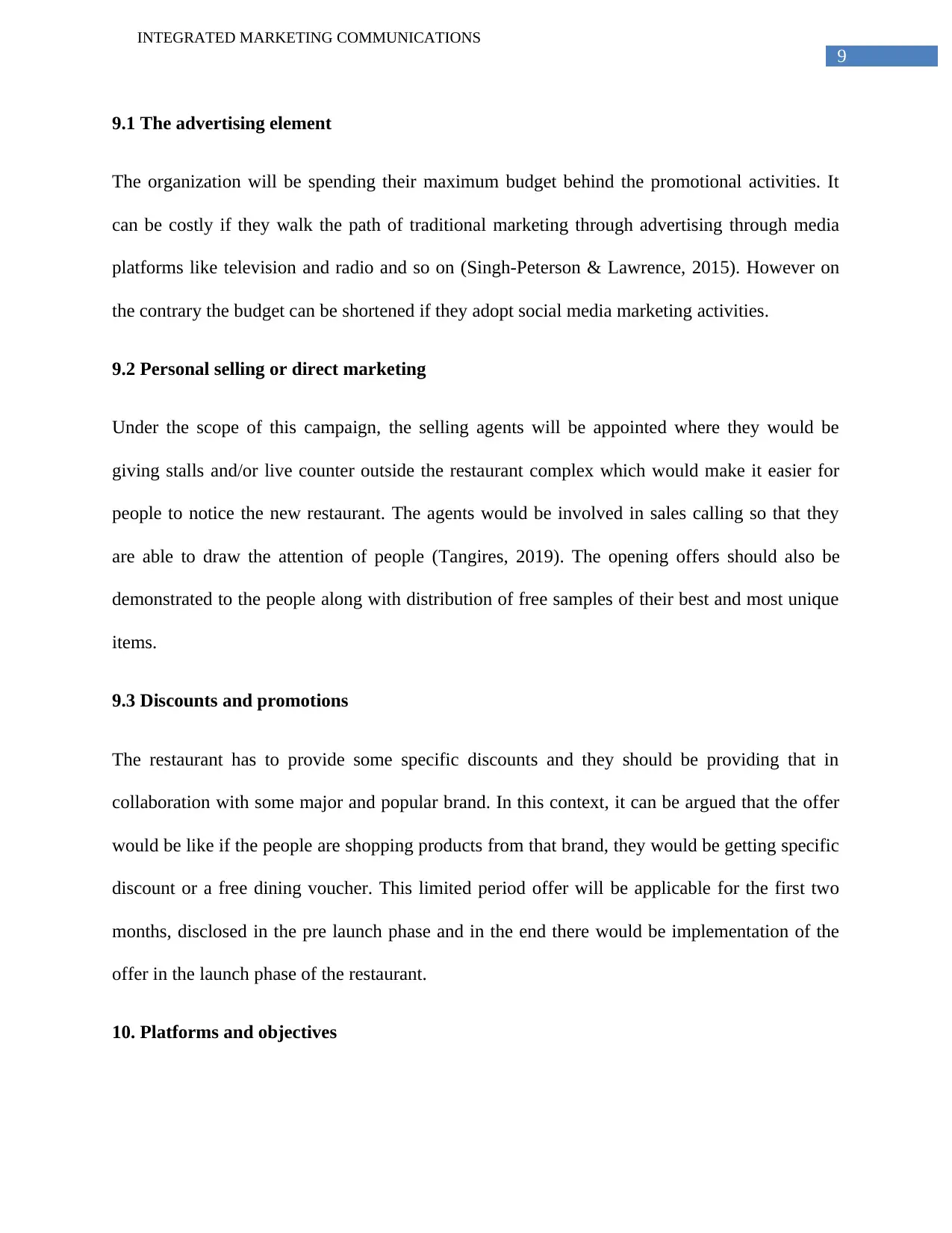
9
INTEGRATED MARKETING COMMUNICATIONS
9.1 The advertising element
The organization will be spending their maximum budget behind the promotional activities. It
can be costly if they walk the path of traditional marketing through advertising through media
platforms like television and radio and so on (Singh-Peterson & Lawrence, 2015). However on
the contrary the budget can be shortened if they adopt social media marketing activities.
9.2 Personal selling or direct marketing
Under the scope of this campaign, the selling agents will be appointed where they would be
giving stalls and/or live counter outside the restaurant complex which would make it easier for
people to notice the new restaurant. The agents would be involved in sales calling so that they
are able to draw the attention of people (Tangires, 2019). The opening offers should also be
demonstrated to the people along with distribution of free samples of their best and most unique
items.
9.3 Discounts and promotions
The restaurant has to provide some specific discounts and they should be providing that in
collaboration with some major and popular brand. In this context, it can be argued that the offer
would be like if the people are shopping products from that brand, they would be getting specific
discount or a free dining voucher. This limited period offer will be applicable for the first two
months, disclosed in the pre launch phase and in the end there would be implementation of the
offer in the launch phase of the restaurant.
10. Platforms and objectives
INTEGRATED MARKETING COMMUNICATIONS
9.1 The advertising element
The organization will be spending their maximum budget behind the promotional activities. It
can be costly if they walk the path of traditional marketing through advertising through media
platforms like television and radio and so on (Singh-Peterson & Lawrence, 2015). However on
the contrary the budget can be shortened if they adopt social media marketing activities.
9.2 Personal selling or direct marketing
Under the scope of this campaign, the selling agents will be appointed where they would be
giving stalls and/or live counter outside the restaurant complex which would make it easier for
people to notice the new restaurant. The agents would be involved in sales calling so that they
are able to draw the attention of people (Tangires, 2019). The opening offers should also be
demonstrated to the people along with distribution of free samples of their best and most unique
items.
9.3 Discounts and promotions
The restaurant has to provide some specific discounts and they should be providing that in
collaboration with some major and popular brand. In this context, it can be argued that the offer
would be like if the people are shopping products from that brand, they would be getting specific
discount or a free dining voucher. This limited period offer will be applicable for the first two
months, disclosed in the pre launch phase and in the end there would be implementation of the
offer in the launch phase of the restaurant.
10. Platforms and objectives
⊘ This is a preview!⊘
Do you want full access?
Subscribe today to unlock all pages.

Trusted by 1+ million students worldwide
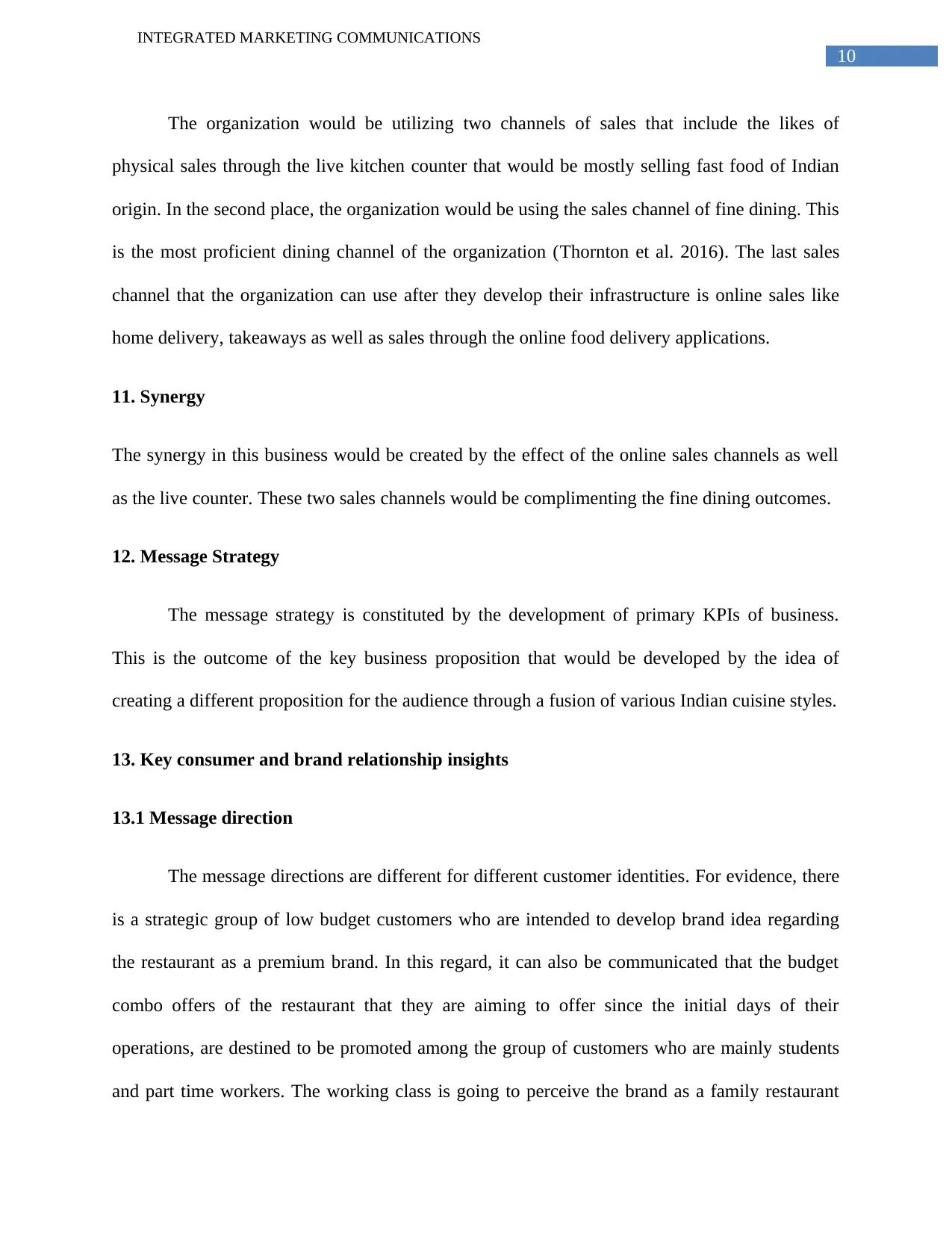
10
INTEGRATED MARKETING COMMUNICATIONS
The organization would be utilizing two channels of sales that include the likes of
physical sales through the live kitchen counter that would be mostly selling fast food of Indian
origin. In the second place, the organization would be using the sales channel of fine dining. This
is the most proficient dining channel of the organization (Thornton et al. 2016). The last sales
channel that the organization can use after they develop their infrastructure is online sales like
home delivery, takeaways as well as sales through the online food delivery applications.
11. Synergy
The synergy in this business would be created by the effect of the online sales channels as well
as the live counter. These two sales channels would be complimenting the fine dining outcomes.
12. Message Strategy
The message strategy is constituted by the development of primary KPIs of business.
This is the outcome of the key business proposition that would be developed by the idea of
creating a different proposition for the audience through a fusion of various Indian cuisine styles.
13. Key consumer and brand relationship insights
13.1 Message direction
The message directions are different for different customer identities. For evidence, there
is a strategic group of low budget customers who are intended to develop brand idea regarding
the restaurant as a premium brand. In this regard, it can also be communicated that the budget
combo offers of the restaurant that they are aiming to offer since the initial days of their
operations, are destined to be promoted among the group of customers who are mainly students
and part time workers. The working class is going to perceive the brand as a family restaurant
INTEGRATED MARKETING COMMUNICATIONS
The organization would be utilizing two channels of sales that include the likes of
physical sales through the live kitchen counter that would be mostly selling fast food of Indian
origin. In the second place, the organization would be using the sales channel of fine dining. This
is the most proficient dining channel of the organization (Thornton et al. 2016). The last sales
channel that the organization can use after they develop their infrastructure is online sales like
home delivery, takeaways as well as sales through the online food delivery applications.
11. Synergy
The synergy in this business would be created by the effect of the online sales channels as well
as the live counter. These two sales channels would be complimenting the fine dining outcomes.
12. Message Strategy
The message strategy is constituted by the development of primary KPIs of business.
This is the outcome of the key business proposition that would be developed by the idea of
creating a different proposition for the audience through a fusion of various Indian cuisine styles.
13. Key consumer and brand relationship insights
13.1 Message direction
The message directions are different for different customer identities. For evidence, there
is a strategic group of low budget customers who are intended to develop brand idea regarding
the restaurant as a premium brand. In this regard, it can also be communicated that the budget
combo offers of the restaurant that they are aiming to offer since the initial days of their
operations, are destined to be promoted among the group of customers who are mainly students
and part time workers. The working class is going to perceive the brand as a family restaurant
Paraphrase This Document
Need a fresh take? Get an instant paraphrase of this document with our AI Paraphraser
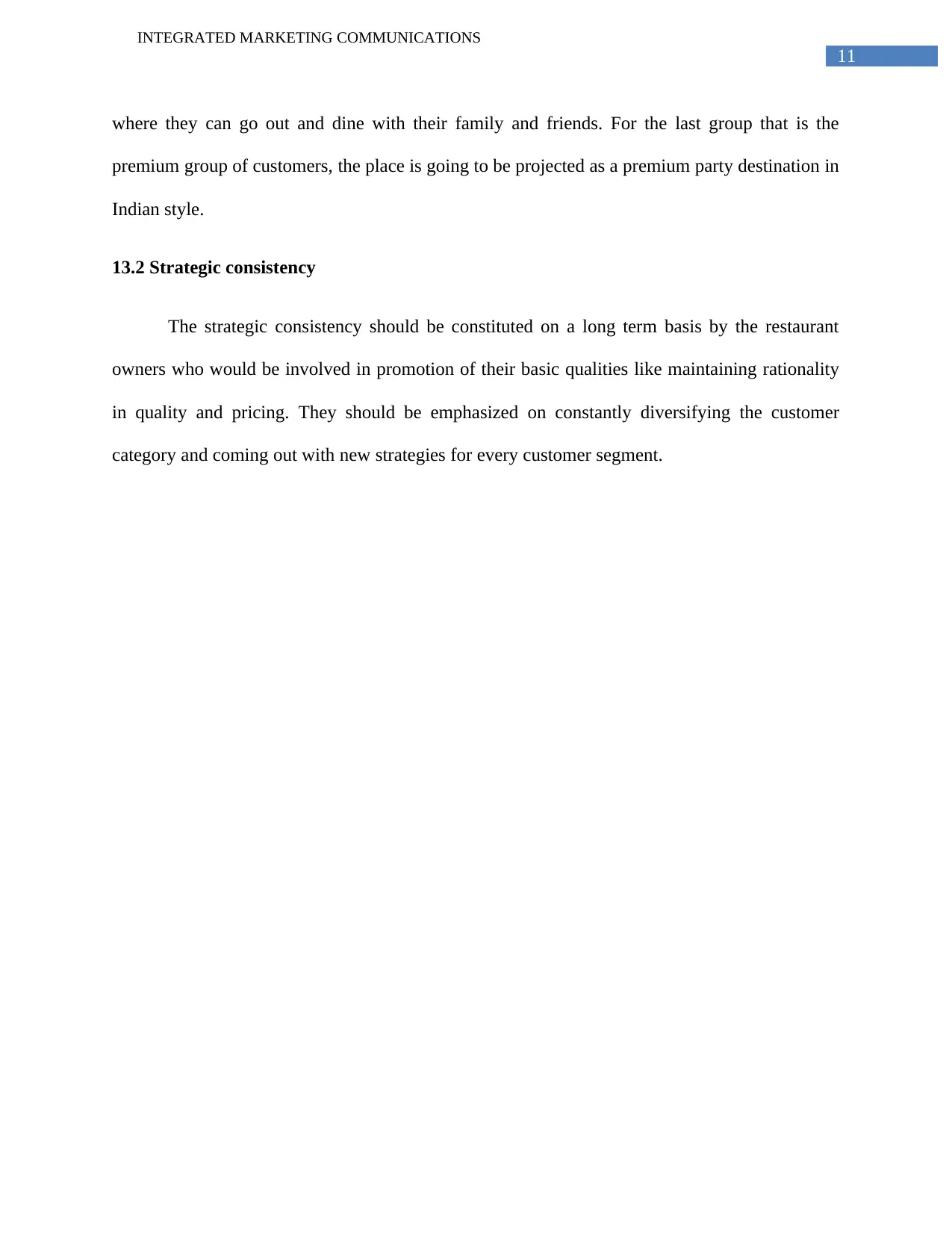
11
INTEGRATED MARKETING COMMUNICATIONS
where they can go out and dine with their family and friends. For the last group that is the
premium group of customers, the place is going to be projected as a premium party destination in
Indian style.
13.2 Strategic consistency
The strategic consistency should be constituted on a long term basis by the restaurant
owners who would be involved in promotion of their basic qualities like maintaining rationality
in quality and pricing. They should be emphasized on constantly diversifying the customer
category and coming out with new strategies for every customer segment.
INTEGRATED MARKETING COMMUNICATIONS
where they can go out and dine with their family and friends. For the last group that is the
premium group of customers, the place is going to be projected as a premium party destination in
Indian style.
13.2 Strategic consistency
The strategic consistency should be constituted on a long term basis by the restaurant
owners who would be involved in promotion of their basic qualities like maintaining rationality
in quality and pricing. They should be emphasized on constantly diversifying the customer
category and coming out with new strategies for every customer segment.
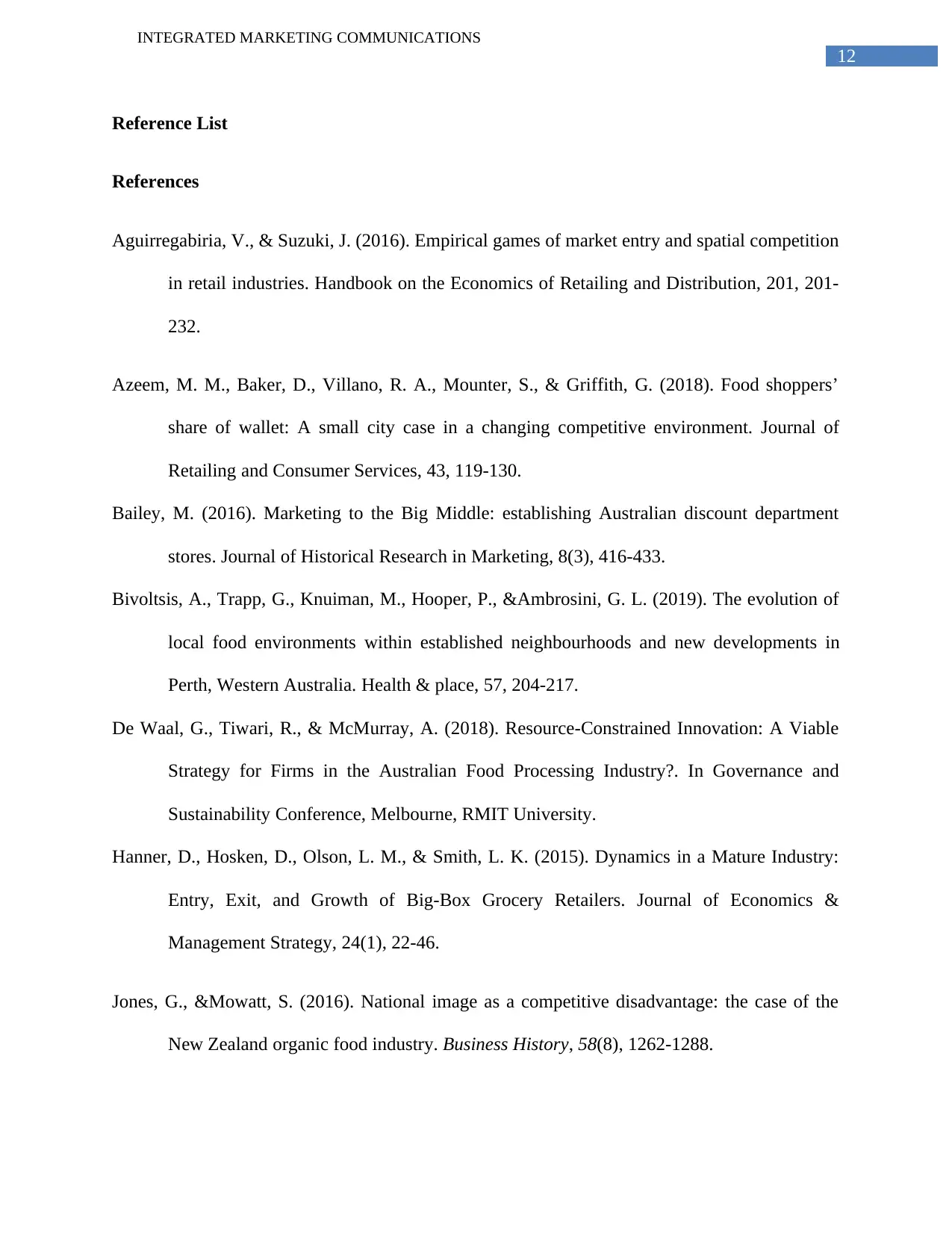
12
INTEGRATED MARKETING COMMUNICATIONS
Reference List
References
Aguirregabiria, V., & Suzuki, J. (2016). Empirical games of market entry and spatial competition
in retail industries. Handbook on the Economics of Retailing and Distribution, 201, 201-
232.
Azeem, M. M., Baker, D., Villano, R. A., Mounter, S., & Griffith, G. (2018). Food shoppers’
share of wallet: A small city case in a changing competitive environment. Journal of
Retailing and Consumer Services, 43, 119-130.
Bailey, M. (2016). Marketing to the Big Middle: establishing Australian discount department
stores. Journal of Historical Research in Marketing, 8(3), 416-433.
Bivoltsis, A., Trapp, G., Knuiman, M., Hooper, P., &Ambrosini, G. L. (2019). The evolution of
local food environments within established neighbourhoods and new developments in
Perth, Western Australia. Health & place, 57, 204-217.
De Waal, G., Tiwari, R., & McMurray, A. (2018). Resource-Constrained Innovation: A Viable
Strategy for Firms in the Australian Food Processing Industry?. In Governance and
Sustainability Conference, Melbourne, RMIT University.
Hanner, D., Hosken, D., Olson, L. M., & Smith, L. K. (2015). Dynamics in a Mature Industry:
Entry, Exit, and Growth of Big‐Box Grocery Retailers. Journal of Economics &
Management Strategy, 24(1), 22-46.
Jones, G., &Mowatt, S. (2016). National image as a competitive disadvantage: the case of the
New Zealand organic food industry. Business History, 58(8), 1262-1288.
INTEGRATED MARKETING COMMUNICATIONS
Reference List
References
Aguirregabiria, V., & Suzuki, J. (2016). Empirical games of market entry and spatial competition
in retail industries. Handbook on the Economics of Retailing and Distribution, 201, 201-
232.
Azeem, M. M., Baker, D., Villano, R. A., Mounter, S., & Griffith, G. (2018). Food shoppers’
share of wallet: A small city case in a changing competitive environment. Journal of
Retailing and Consumer Services, 43, 119-130.
Bailey, M. (2016). Marketing to the Big Middle: establishing Australian discount department
stores. Journal of Historical Research in Marketing, 8(3), 416-433.
Bivoltsis, A., Trapp, G., Knuiman, M., Hooper, P., &Ambrosini, G. L. (2019). The evolution of
local food environments within established neighbourhoods and new developments in
Perth, Western Australia. Health & place, 57, 204-217.
De Waal, G., Tiwari, R., & McMurray, A. (2018). Resource-Constrained Innovation: A Viable
Strategy for Firms in the Australian Food Processing Industry?. In Governance and
Sustainability Conference, Melbourne, RMIT University.
Hanner, D., Hosken, D., Olson, L. M., & Smith, L. K. (2015). Dynamics in a Mature Industry:
Entry, Exit, and Growth of Big‐Box Grocery Retailers. Journal of Economics &
Management Strategy, 24(1), 22-46.
Jones, G., &Mowatt, S. (2016). National image as a competitive disadvantage: the case of the
New Zealand organic food industry. Business History, 58(8), 1262-1288.
⊘ This is a preview!⊘
Do you want full access?
Subscribe today to unlock all pages.

Trusted by 1+ million students worldwide
1 out of 13
Related Documents
Your All-in-One AI-Powered Toolkit for Academic Success.
+13062052269
info@desklib.com
Available 24*7 on WhatsApp / Email
![[object Object]](/_next/static/media/star-bottom.7253800d.svg)
Unlock your academic potential
Copyright © 2020–2025 A2Z Services. All Rights Reserved. Developed and managed by ZUCOL.





